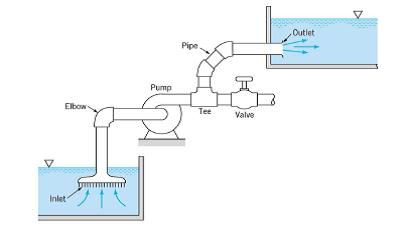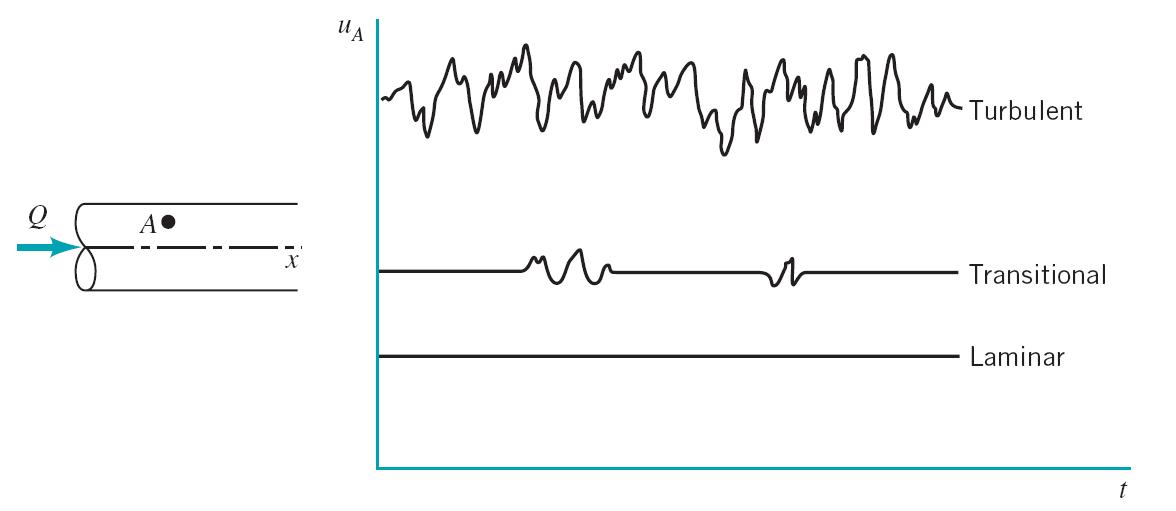Site pages
Current course
Participants
General
MODULE 1. FLUIDS MECHANICS
MODULE 2. PROPERTIES OF FLUIDS
MODULE 3. PRESSURE AND ITS MEASUREMENT
MODULE 4. PASCAL’S LAW
MODULE 5. PRESSURE FORCES ON PLANE AND CURVED SUR...
MODULE 6.
MODULE 7. BUOYANCY, METACENTRE AND METACENTRIC HEI...
MODULE 8. KINEMATICS OF FLUID FLOW
MODULE 9: CIRCULATION AND VORTICITY
MODULE 10.
MODULE 11.
MODULE 12, 13. FLUID DYNAMICS
MODULE 14.
MODULE 15. LAMINAR AND TURBULENT FLOW IN PIPES
MODULE 16. GENERAL EQUATION FOR HEAD LOSS-DARCY EQ...
MODULE 17.
MODULE 18. MAJOR AND MINOR HYDRAULIC LOSSES THROUG...
MODULE 19.
MODULE 20.
MODULE 21. DIMENSIONAL ANALYSIS AND SIMILITUDE
MODULE 22. INTRODUCTION TO FLUID MACHINERY
LESSON 23. FLOW IN PIPES
what is Pipe?
- A pipe is a closed conduit through which a fluid flows.
- Includes water pipes, hydraulic hoses. Circular cross section is able withstand higher pressure differentials without distortion.
- The water pipes suppling water in the house. The hypodermic needle use by heroin junkies. Pipes can be natural (veins and arteries) as well as artificial.
- Pipes can transport both liquid and gases.
- Pipe systems consists of inlets, outlets, the pipe itself, bends in the pipe, valves and pumps

General characteristics of pipe flow

- A closed conduit is called a duct if it is square in cross section, e.g. heating and air-conditioning ducts. Lower pressure differential across wall of duct.
- The water flowing down the conduit completely fills the conduit. Storm water drains, sewers.
- If water does not fill the conduit, the flow is called channel flow. Since channel is not filled, no pressure differential between ends of pipes. Gravity is usually the driver for channel flows.
Laminar and turbulent flow
- Take a pipe of free flowing water and inject a dye into the middle of the stream, different views will be available as shown in figure below:



- In laminar flow the motion of the particles of fluid is very orderly with all particles moving in straight lines parallel to the pipe walls.
- The laminar flow has a constant uA which is smallest.
- The transitional flow has a mostly constant uA with the occasional fluctuation.
- The phenomenon was first investigated in the 1880s by Osbourne Reynolds in an experiment which has become a classic in fluid mechanics. He used a tank arranged as above with a pipe taking water from the centre into which he injected a dye through a needle. After many experiments he saw that this expression
The Reynolds number
Whether a flow will result in laminar or turbulent flow is primarily determined by the Reynolds number,
Where density is ρ , diameter of pipe is D , v is fluid velocity and μ is viscosity.
Re values depend on shape of pipe, roughness, shape of pipe inlet. The limits are also soft numbers.
Laminar flow
- Re < 2000
- 'low' velocity
- Dye does not mix with water
- Fluid particles move in straight lines
- Simple mathematical analysis possible
- Rare in practice in water systems.
Transitional flow
- 2000 > Re < 4000
- 'medium' velocity
- Dye stream wavers in water - mixes slightly.
Turbulent flow
- Re > 4000
- 'high' velocity
- Dye mixes rapidly and completely
- Particle paths completely irregular
- Average motion is in the direction of the flow
- Cannot be seen by the naked eye
- Changes/fluctuations are very difficult to detect. Must use laser.
- Mathematical analysis very difficult - so experimental measures are used
- Most common type of flow.
Last modified: Monday, 16 September 2013, 10:23 AM